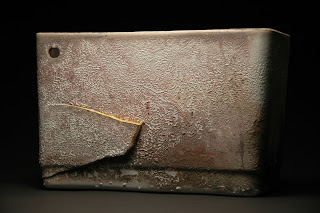
is pleased to have with us this fall and winter quarters,
Brian Benfer.
 These pieces are from his Industrial Ceramics Series. From his website:
These pieces are from his Industrial Ceramics Series. From his website:industrial ceramics have enabled me a continued participation in what i view as being the most significant traditional aspect of the discipline: the fire. through the medieval wood-fired process, the residual provides an object that has undergone an experiential transformation of both heat and fire. it provokes an interesting dialogue between the “old” and the “new” by presenting an honest focus on elements of the fire without creating a “pallet” (i.e. object)—thus challenging the intentions of the makers in utilizing a process serving to beautify a static object. i have found this transformation to be better understood, visually, by utilizing an everyday, recognizable object. the work entertains multiple conversations including contemporary wood-fired ceramics, asian aesthetics, duchamp/dada and the tea ceremony. for that reason i have focused primarily on porcelain bathroom furniture, revisiting historical associations involving vessels containing liquid.
 a second aspect of the series deals the kiln’s/fire’s role change from being primarily surface-oriented to that of “maker.” while unearthing shards of thermal expansion, other considerations were revealed. among them were those of environmental consciousness—implications of recycling the excess material via reassembly versus discarding them—archeological associations—an homage to the work of the museum conservator—and last, considerations of historical eastern practices—the filling of exposed cracks with gold.
a second aspect of the series deals the kiln’s/fire’s role change from being primarily surface-oriented to that of “maker.” while unearthing shards of thermal expansion, other considerations were revealed. among them were those of environmental consciousness—implications of recycling the excess material via reassembly versus discarding them—archeological associations—an homage to the work of the museum conservator—and last, considerations of historical eastern practices—the filling of exposed cracks with gold. 













































